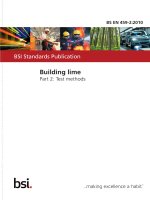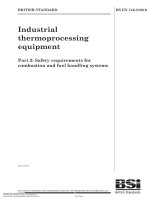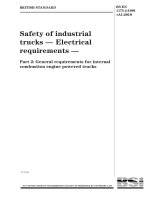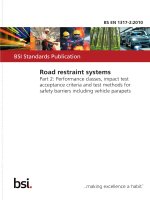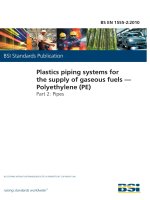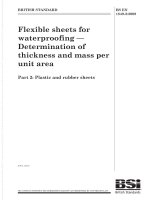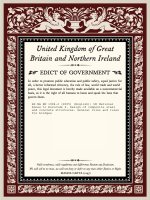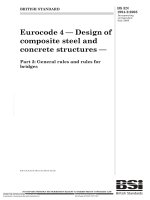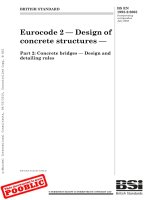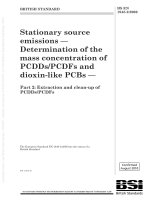Bsi bs en 61010 2 030 2010
Bạn đang xem bản rút gọn của tài liệu. Xem và tải ngay bản đầy đủ của tài liệu tại đây (1.55 MB, 34 trang )
BS EN 61010-2-030:2010
Licensed Copy: Wang Bin, ISO/EXCHANGE CHINA STANDARDS, 30/11/2011 06:21, Uncontrolled Copy, (c) BSI
Incorporating corrigendum May 2010
BSI Standards Publication
Safety requirements for
electrical equipment for
measurement, control,
and laboratory use
Part 2-030: Particular requirements for
testing and measuring circuits
NO COPYING WITHOUT BSI PERMISSION EXCEPT AS PERMITTED BY COPYRIGHT LAW
raising standards worldwide™
BRITISH STANDARD
BS EN 61010-2-030:2010
National foreword
This British Standard is the UK implementation of EN 61010-2-030:2010. It is
identical to IEC 61010-2-030:2010, incorporating corrigendum May 2010.
Licensed Copy: Wang Bin, ISO/EXCHANGE CHINA STANDARDS, 30/11/2011 06:21, Uncontrolled Copy, (c) BSI
The start and finish of text introduced or altered by corrigendum is indicated
in the text by tags. Text altered by IEC corrigendum May 2010 is indicated in
the text by ˆ‰ .
The UK participation in its preparation was entrusted to Technical Committee
EPL/66, Safety of measuring, control and laboratory equipment.
A list of organizations represented on this committee can be obtained on
request to its secretary.
This publication does not purport to include all the necessary provisions of a
contract. Users are responsible for its correct application.
©
BSI 2011
ISBN 978 0 580 75548 4
ICS 19.080; 71.040.10
Compliance with a British Standard cannot confer immunity from
legal obligations.
This British Standard was published under the authority of the Standards
Policy and Strategy Committee on 30 November 2010.
Amendments/corrigenda issued since publication
Date
Text affected
31 July 2011
Implementation of IEC corrigendum May 2010
EUROPEAN STANDARD
EN 61010-2-030
NORME EUROPÉENNE
October 2010
EUROPÄISCHE NORM
ICS 19.080; 71.040.10
Licensed Copy: Wang Bin, ISO/EXCHANGE CHINA STANDARDS, 30/11/2011 06:21, Uncontrolled Copy, (c) BSI
English version
Safety requirements for electrical equipment for measurement, control,
and laboratory use Part 2-030: Particular requirements for testing and measuring circuits
(IEC 61010-2-030:2010)
Règles de sécurité pour appareils
électriques de mesurage, de régulation et
de laboratoire Partie 2-030: Exigences particulières pour
les circuits de test et de mesure
(CEI 61010-2-030:2010)
Sicherheitsbestimmungen für elektrische
Mess-, Steuer-, Regel- und Laborgeräte Teil 2-030: Besondere Bestimmungen für
Prüf- und Messkreise
(IEC 61010-2-030:2010)
This European Standard was approved by CENELEC on 2010-10-01. CENELEC members are bound to comply
with the CEN/CENELEC Internal Regulations which stipulate the conditions for giving this European Standard
the status of a national standard without any alteration.
Up-to-date lists and bibliographical references concerning such national standards may be obtained on
application to the Central Secretariat or to any CENELEC member.
This European Standard exists in three official versions (English, French, German). A version in any other
language made by translation under the responsibility of a CENELEC member into its own language and notified
to the Central Secretariat has the same status as the official versions.
CENELEC members are the national electrotechnical committees of Austria, Belgium, Bulgaria, Croatia, Cyprus,
the Czech Republic, Denmark, Estonia, Finland, France, Germany, Greece, Hungary, Iceland, Ireland, Italy,
Latvia, Lithuania, Luxembourg, Malta, the Netherlands, Norway, Poland, Portugal, Romania, Slovakia, Slovenia,
Spain, Sweden, Switzerland and the United Kingdom.
CENELEC
European Committee for Electrotechnical Standardization
Comité Européen de Normalisation Electrotechnique
Europäisches Komitee für Elektrotechnische Normung
Management Centre: Avenue Marnix 17, B - 1000 Brussels
© 2010 CENELEC -
All rights of exploitation in any form and by any means reserved worldwide for CENELEC members.
Ref. No. EN 61010-2-030:2010 E
BS EN 61010-2-030:2010
EN 61010-2-030:2010 (E)
–2–
Foreword
Licensed Copy: Wang Bin, ISO/EXCHANGE CHINA STANDARDS, 30/11/2011 06:21, Uncontrolled Copy, (c) BSI
The text of document 66/417/FDIS, future edition 1 of IEC 61010-2-030, prepared by IEC TC 66, Safety
of measuring, control and laboratory equipment, was submitted to the IEC-CENELEC parallel vote and
was approved by CENELEC as EN 61010-2-030 on 2010-10-01.
Attention is drawn to the possibility that some of the elements of this document may be the subject of
patent rights. CEN and CENELEC shall not be held responsible for identifying any or all such patent
rights.
The following dates were fixed:
– latest date by which the EN has to be implemented
at national level by publication of an identical
national standard or by endorsement
(dop)
2011-07-01
– latest date by which the national standards conflicting
with the EN have to be withdrawn
(dow)
2013-10-01
This Part 2-030 is to be used in conjunction with the latest edition of EN 61010-1, Safety requirements for
electrical equipment for measurement, control and laboratory use - Part 1: General requirements. It was
established on the basis of the 2010 edition of EN 61010-1. Amendments and revisions of Part 1 have
also to be taken into account and the dates when such changes become applicable will be stated in the
relevant amendment or revision of Part 1.
This Part 2-030 supplements or modifies the corresponding clauses in EN 61010-1 so as to convert it into
the European Standard: Particular requirements for testing and measuring circuits.
Where a particular subclause of Part 1 is not mentioned in this part 2, that subclause applies as far as is
reasonable. Where this part states “addition”, “modification”, “replacement”, or “deletion” the relevant
requirement, test specification or note in Part 1 should be adapted accordingly.
In the second edition of EN 61010-1, the requirements for testing and measuring circuits were included in
Part 1 itself. In the third edition of EN 61010-1, these requirements have been removed from Part 1 and
have become the basis for the requirements in this Part 2.
In addition to the requirements removed from Part 1, the following major requirements have been added
to this standard. Numerous other changes have also been made.
− The terminology for MEASUREMENT CATEGORY I has changed. In this Part 2, it is termed “not rated for
measurements within MEASUREMENT CATEGORIES II, III, or IV”.
− CLEARANCES and CREEPAGE DISTANCES have been added for unmated measuring circuit TERMINALS.
− Requirements have been added for specialized measuring circuit TERMINALS.
− Requirements for TRANSIENT OVERVOLTAGE limiting devices have been revised.
− Requirements have been revised and added pertaining to REASONABLY FORESEEABLE MISUSE of
measuring circuits, including disconnection of the protective earth and usage of the equipment in a
manner that might cause arc flash.
− Insulation requirements for measuring circuits have been primarily located in Annex K.
− Annex AA has been added to describe the characteristics of MEASUREMENT CATEGORIES.
− Annex BB has been added to describe hazards that may be encountered when using measuring
circuits.
NOTE 1
–
The following print types are used:
requirements: in roman type;
–3–
BS EN 61010-2-030:2010
EN 61010-2-030:2010 (E)
conformity and test: in italic type;
– NOTES: in small roman type;
–
–
terms used throughout this standard which have been defined in Clause 3: SMALL ROMAN CAPITALS;
NOTE 2 Subclauses, figures, tables and notes which are additional to those in Part 1 are numbered starting from 101. Additional
Annexes are numbered AA and BB.
Licensed Copy: Wang Bin, ISO/EXCHANGE CHINA STANDARDS, 30/11/2011 06:21, Uncontrolled Copy, (c) BSI
Annex ZA of Part 1 is applicable.
__________
Endorsement notice
The text of the International Standard IEC 61010-2-030:2010 was approved by CENELEC as a European
Standard without any modification.
__________
Bibliography
Add the following reference to the Bibliography of Part 1:
EN 41003:1999
IEC 61010-2-032
NOTE
Harmonized as EN 61010-2-032
BS EN 61010-2-030:2010
EN 61010-2-030:2010 (E)
–4–
Licensed Copy: Wang Bin, ISO/EXCHANGE CHINA STANDARDS, 30/11/2011 06:21, Uncontrolled Copy, (c) BSI
CONTENTS
1
Scope and object ...........................................................................................................6
2
Normative references.....................................................................................................6
3
Terms and definitions ....................................................................................................6
4
Tests .............................................................................................................................7
5
Marking and documentation ...........................................................................................7
6
Protection against electric shock....................................................................................8
7
Protection against mechanical HAZARDS ....................................................................... 11
8
Resistance to mechanical stresses .............................................................................. 11
9
Protection against the spread of fire ............................................................................ 11
10
Equipment temperature limits and resistance to heat ................................................... 11
11
Protection against HAZARDS from fluids ........................................................................ 11
12
Protection against radiation, including laser sources, and against sonic and
ultrasonic pressure ...................................................................................................... 11
13
Protection against liberated gases and substances, explosion and implosion............... 11
14
Components and subassemblies.................................................................................. 11
15
Protection by interlocks ............................................................................................... 12
16
H AZARDS resulting from application .............................................................................. 12
17
R ISK assessment.......................................................................................................... 12
101
Measuring circuits........................................................................................................ 12
Annexes ............................................................................................................................... 17
Annex K (normative) Insulation requirements not covered by 6.7 ......................................... 17
Annex L (informative) Index of defined terms ....................................................................... 23
Annex AA (normative) Measurement categories ................................................................... 24
Annex BB (informative) Hazards pertaining to measurements performed in certain
environments ........................................................................................................................ 27
Bibliography.......................................................................................................................... 30
Figure AA.1 – Example to identify the locations of measuring circuits ................................... 27
Table 101 – C LEARANCES and CREEPAGE DISTANCES for measuring circuit TERMINALS
with HAZARDOUS LIVE conductive parts ................................................................................... 10
Table 102 – Impulse withstand voltages................................................................................ 12
Table K.101 – C LEARANCES for MEASUREMENT CATEGORIES II, III and IV ................................. 18
Table K.102 – Test voltages for testing electric strength of solid insulation in
measuring circuits of MEASUREMENT CATEGORY II ...................................................................19
Table K.103 – Test voltages for solid insulation in measuring circuits of
MEASUREMENT CATEGORY III ...................................................................................................19
Table K.104 – Test voltages for testing electric strength of solid insulation in
measuring circuits of MEASUREMENT CATEGORY IV ..................................................................19
Table K.105 – Test voltages for testing long term stress of solid insulation in
measuring circuits................................................................................................................. 20
Table K.106 – Maximum TRANSIENT OVERVOLTAGES ............................................................... 22
–5–
BS EN 61010-2-030:2010
EN 61010-2-030:2010 (E)
Licensed Copy: Wang Bin, ISO/EXCHANGE CHINA STANDARDS, 30/11/2011 06:21, Uncontrolled Copy, (c) BSI
Table AA.1 – Characteristics of MEASUREMENT CATEGORIES ................................................... 26
BS EN 61010-2-030:2010
EN 61010-2-030:2010 (E)
–6–
SAFETY REQUIREMENTS FOR ELECTRICAL EQUIPMENT
FOR MEASUREMENT, CONTROL, AND LABORATORY USE –
Licensed Copy: Wang Bin, ISO/EXCHANGE CHINA STANDARDS, 30/11/2011 06:21, Uncontrolled Copy, (c) BSI
Part 2-030: Particular requirements for testing and measuring circuits
1
Scope and object
This clause of Part 1 is applicable except as follows:
1.1.1
Equipment included in scope
Replace the text with the following:
This part of IEC 61010 specifies safety requirements for testing and measuring circuits
which are connected for test or measurement purposes to devices or circuits outside the
measurement equipment itself.
These include measurement circuits which are part of electrical test and measurement
equipment, laboratory equipment, or process control equipment. The existence of these
circuits in equipment requires additional protective means between the circuit and an
OPERATOR .
NOTE 1
–
These testing and measuring circuits may, for example:
measure voltages in circuits of other equipment,
–
measure temperature of a separate device via a thermocouple,
–
measure force on a separate device via a strain gauge,
–
inject a voltage onto a circuit to analyze a new design.
NOTE 2 Testing and measuring circuits that are not within the scope of this Part 2 are considered to be
covered by the requirements of Part 1.
NOTE 3 Equipment containing these testing and measuring circuits may be intended for performing tests and
measurements on hazardous conductors, including MAINS conductors and telecommunication network
conductors. See Annex BB for considerations of HAZARDS involved in various tests and measurements.
2
Normative references
This clause of Part 1 is applicable.
3
Terms and definitions
This clause of Part 1 is applicable except as follows:
3.5
Safety terms
Add a new definition:
3.5.101
MEASUREMENT CATEGORY
classification of testing and measuring circuits according to the type of MAINS CIRCUITS to
which they are intended to be connected
–7–
BS EN 61010-2-030:2010
EN 61010-2-030:2010 (E)
NOTE M EASUREMENT CATEGORIES take into account OVERVOLTAGE CATEGORIES , short-circuit current levels, the
location in the building installation at which the test or measurement is to be made, and some forms of energy
limitation or transient protection included in the building installation. See Annex AA for more information.
4
Tests
Licensed Copy: Wang Bin, ISO/EXCHANGE CHINA STANDARDS, 30/11/2011 06:21, Uncontrolled Copy, (c) BSI
This clause of Part 1 is applicable.
5
Marking and documentation
This clause of Part 1 is applicable, except as follows:
5.1.5
T ERMINALS , connections and operating devices
Add a new subclause:
5.1.5.101 Measuring circuit TERMINALS
5.1.5.101.1
General
Except as permitted in 5.1.5.101.4:
a) the RATED voltage to earth of measuring circuit TERMINALS shall be marked, and
b) the RATED voltage or the RATED current, as applicable, of each pair or set of measuring
circuit TERMINALS that are intended to be used together shall be marked, and
c) the pertinent MEASUREMENT CATEGORY for each pair or set of measuring circuit
TERMINALS or symbol 14 of Table 1 of Part 1 shall be marked as specified in
5.1.5.101.2 and 5.1.5.101.3, if applicable.
NOTE 1 Measuring circuit TERMINALS are usually supplied in pairs or sets. Each pair or set of TERMINALS may
have a RATED voltage or a RATED current, or both, within that set, and each individual TERMINAL may have a
RATED voltage to earth. Some instruments may have a measurement RATED voltage (between TERMINALS )
different from the RATED voltage to earth. Markings should be clear to avoid misunderstanding.
Symbol 14 of Table 1 shall be marked if current measuring TERMINALS are not intended for
connection to current transformers without internal protection (see 101.2).
Markings shall be placed adjacent to the TERMINALS . However, if there is insufficient space
(as in multi-input equipment), the marking may be on the RATING plate or scale plate, or the
TERMINAL may be marked with symbol 14 of Table 1.
NOTE 2 For any set of measuring circuit TERMINALS , symbol 14 of Table 1 does not need to be marked more
than once, if it is close to the TERMINALS .
Conformity is checked by inspection and, if applicable, as specified in 5.1.5.101.2 and
5.1.5.101.3, taking into account the exceptions in 5.1.5.101.4.
5.1.5.101.2
Measuring circuit TERMINALS RATED for MEASUREMENT CATEGORIES II, III
or IV
The relevant MEASUREMENT CATEGORY shall be marked for measuring circuit TERMINALS
measurements within MEASUREMENT CATEGORIES II, III or IV. The MEASUREMENT
markings shall be “CAT II”, “CAT III” or “CAT IV” as applicable.
RATED for
CATEGORY
NOTE Marking more than one type of MEASUREMENT CATEGORY and its RATED voltage to earth is permissible
(see also 5.1.5.101.1, Note 1).
Conformity is checked by inspection.
BS EN 61010-2-030:2010
EN 61010-2-030:2010 (E)
5.1.5.101.3
–8–
Measuring circuit TERMINALS RATED for connection to voltages above the
level of 6.3.1
Licensed Copy: Wang Bin, ISO/EXCHANGE CHINA STANDARDS, 30/11/2011 06:21, Uncontrolled Copy, (c) BSI
Symbol 14 of Table 1 shall be marked for measuring circuit TERMINALS RATED for
connection to voltages above the levels of 6.3.1, but that are not RATED for measurements
within MEASUREMENT CATEGORIES II, III or IV (see also 5.4.1 bb)).
Conformity is checked by inspection.
5.1.5.101.4
Low voltage, permanently connected, or dedicated measuring circuit
TERMINALS
Measuring circuit TERMINALS do not need to be marked if
a) they are intended to be permanently connected and not ACCESSIBLE (see 5.4.3 aa) and
bb)), or
b) they are dedicated only for connection to specific TERMINALS of other equipment, or;
c) it is obvious from other indications that the RATED voltage is below the levels of 6.3.1.
NOTE Examples of acceptable indications that the inputs are intended to be less than the levels of 6.3.1
include:
–
the full scale deflection marking of a single-range indicating voltmeter or ammeter or maximum
marking of a multi-range multimeter;
–
the maximum range marking of a voltage selector switch;
–
a marked voltage or power rating expressed in dB, mW or W, where the equivalent value, as explained
in the documentation, is below 33 V a.c.
5.4.1
General
Add new items to the list:
aa)
information about each relevant MEASUREMENT CATEGORY if the measuring circuit has
a RATING for MEASUREMENT CATEGORY II, III or IV (see 5.1.5.101.2);
bb)
for measuring circuits that do not have a RATING for MEASUREMENT CATEGORY II, III or
IV, but could be misused by connection to such circuits, a warning not to use the
equipment for measurements on MAINS CIRCUITS , and a detailed RATING including
TRANSIENT OVERVOLTAGES (see AA.2.4 for more information).
NOTE Some equipment may have multiple MEASUREMENT CATEGORY RATINGS for the same measuring circuit.
For such equipment, the documentation needs to clearly identify the MEASUREMENT CATEGORIES where the
equipment is intended to be used and where it must not be used.
5.4.3
Equipment installation
Add new items to the list:
aa)
for permanently connected measuring circuit TERMINALS RATED for MEASUREMENT
CATEGORIES II, III or IV, information regarding the MEASUREMENT CATEGORY , RATED
maximum WORKING VOLTAGE , and RATED maximum current, as applicable (see
5.1.5.101);
bb)
for permanently connected measuring circuit TERMINALS that are not RATED for
MEASUREMENT CATEGORIES II, III or IV, information regarding the RATED maximum
WORKING VOLTAGE , RATED maximum current, and RATED maximum TRANSIENT
OVERVOLTAGES as applicable (see 5.1.5.101).
6
Protection against electric shock
This clause of Part 1 is applicable except as follows:
–9–
6.1.2
BS EN 61010-2-030:2010
EN 61010-2-030:2010 (E)
Exceptions
Add a new item to the list:
Licensed Copy: Wang Bin, ISO/EXCHANGE CHINA STANDARDS, 30/11/2011 06:21, Uncontrolled Copy, (c) BSI
aa)
locking or screw-held type measuring TERMINALS , including TERMINALS which do not
require the use of a TOOL .
6.5.2.1
General
Replace the conformity statement with the following:
Conformity is checked as specified in 6.5.2.2 to 6.5.2.6 and 6.5.2.101.
6.5.2.3
P ROTECTIVE CONDUCTOR TERMINAL
Replace h) 2) with the following h) 2):
h) 2) the PROTECTIVE BONDING shall not be interrupted by any switching or interrupting
device. Devices used for indirect bonding in test and measurement circuits (see
6.5.2.101) are permitted to be part of the PROTECTIVE BONDING .
Add a new subclause:
6.5.2.101 Indirect bonding for testing and measuring circuits
Indirect bonding establishes a connection between the PROTECTIVE CONDUCTOR TERMINAL
and ACCESSIBLE conductive parts if these become HAZARDOUS LIVE as a result of a fault.
Devices to establish indirect bonding are:
a) voltage limiting devices which become conductive when the voltage across them
exceeds the relevant levels of 6.3.2 a), with overcurrent protection to prevent
breakdown of the device;
Conformity is checked by connecting the ACCESSIBLE conductive parts to the MAINS
supply TERMINALS while the equipment is connected to the MAINS supply as in NORMAL
USE . The voltage between the ACCESSIBLE conductive parts and the PROTECTIVE
CONDUCTOR TERMINAL shall not exceed the relevant levels of 6.3.2 a) for more than
0,2 s.
b) voltage-sensitive tripping devices which interrupt all poles of the MAINS supply, and
connect the ACCESSIBLE conductive parts to the PROTECTIVE CONDUCTOR TERMINAL
whenever the voltage across them reaches the relevant levels of 6.3.2 a).
Conformity is checked by applying the relevant voltage level of 6.3.2 a) between the
ACCESSIBLE conductive parts and the PROTECTIVE CONDUCTOR TERMINAL . The tripping
action shall take place within 0,2 s.
6.6
Connections to external circuits
Add new subclauses:
6.6.101
Measuring circuit TERMINALS
Conductive parts of each unmated measuring circuit TERMINAL which could become
HAZARDOUS LIVE when the maximum RATED voltage is applied to other measuring circuit
TERMINALS on the equipment shall be separated by at least the CLEARANCE and CREEPAGE
DISTANCE of Table 101 from the closest approach of the test finger touching the external
parts of the TERMINAL in the least favourable position. See Figure 1 of Part 1.
BS EN 61010-2-030:2010
EN 61010-2-030:2010 (E)
– 10 –
Table 101 – C LEARANCES and CREEPAGE DISTANCES for measuring circuit TERMINALS with
HAZARDOUS LIVE conductive parts
Licensed Copy: Wang Bin, ISO/EXCHANGE CHINA STANDARDS, 30/11/2011 06:21, Uncontrolled Copy, (c) BSI
Voltage on conductive parts of TERMINAL
C LEARANCE and
CREEPAGE DISTANCE
V a.c. r.m.s.
V d.c.
mm
≥33 ≤ 300
≥70 ≤ 414
0,8
>300 ≤ 600
>414 ≤ 848
1,0
>600 ≤ 1 000
>848 ≤ 1 414
2,6
NOTE Values are determined by calculation for REINFORCED INSULATION . Transients are not taken into
account.
Conformity is checked by inspection and measurement.
6.6.102
Specialized measuring circuit TERMINALS
Components, sensors, and devices intended to be connected to specialized measuring
circuit TERMINALS shall not be both ACCESSIBLE and HAZARDOUS LIVE , in either NORMAL
CONDITION or SINGLE - FAULT CONDITION , even when the maximum RATED voltage is applied to
any other measuring circuit TERMINAL .
NOTE These specialized TERMINALS include, but are not limited to, TERMINALS for semiconductor measuring
functions, capacitance measurements, and thermocouple sockets.
Conformity is checked by inspection and measurement. Components, sensors, and devices
intended to be connected to specialized measuring circuit TERMINALS are connected. The
measurements of 6.3 are made to establish that the levels of 6.3.1 and 6.3.2 are not
exceeded when each of the following voltages is applied to each other measuring circuit
TERMINAL , if applicable:
a) maximum RATED a.c. voltage at any RATED MAINS frequency;
b) maximum RATED d.c. voltage;
c) maximum RATED a.c. voltage at the maximum RATED measurement frequency.
6.9
Constructional requirements for protection against electric shock
Add a new subclause:
6.9.101 Over-range indication
If a HAZARD could arise from an OPERATOR ' S reliance on the value (for example, voltage)
displayed by the equipment, the display shall give an unambiguous indication whenever
the value is above the maximum positive value or below the minimum negative value of the
range to which the equipment is set.
NOTE Examples of ambiguous indications include the following, unless there is a separate unambiguous
indication of an over-range value:
a)
analogue meters with stops at the exact ends of the range;
b)
digital meters which show a low value when the true value is above the range maximum (for example
1 001,5 V displayed as 001,5 V);
c)
chart recorders which print a trace at the edge of the chart, thus indicating a value at the range
maximum when the true value is higher.
Conformity is checked by inspection and by provoking an over-range value.
BS EN 61010-2-030:2010
EN 61010-2-030:2010 (E)
– 11 –
7
Protection against mechanical HAZARDS
This clause of Part 1 is applicable.
Licensed Copy: Wang Bin, ISO/EXCHANGE CHINA STANDARDS, 30/11/2011 06:21, Uncontrolled Copy, (c) BSI
8
Resistance to mechanical stresses
This clause of Part 1 is applicable.
9
Protection against the spread of fire
This clause of Part 1 is applicable.
10 Equipment temperature limits and resistance to heat
This clause of Part 1 is applicable.
11 Protection against HAZARDS from fluids
This clause of Part 1 is applicable.
12 Protection against radiation, including laser sources, and against sonic
and ultrasonic pressure
This clause of Part 1 is applicable.
13 Protection against liberated gases and substances, explosion and
implosion
This clause of Part 1 is applicable.
14 Components and subassemblies
This clause of Part 1 is applicable, except as follows:
Add a new subclause:
14.101
Circuits or components used as TRANSIENT OVERVOLTAGE limiting devices in
measuring circuits used to measure MAINS
If control of TRANSIENT OVERVOLTAGE is employed in
MAINS , any overvoltage limiting component or circuit
likely TRANSIENT OVERVOLTAGES .
a measuring circuit used to measure
shall have adequate strength to limit
Conformity is checked by applying 5 positive and 5 negative impulses with the applicable
impulse withstand voltage of Table 102, spaced up to 1 min apart, from a hybrid impulse
generator (see IEC 61180-1). The generator shall produce an open-circuit voltage
waveform of 1,2/50 μs, a short-circuit current waveform of 8/20 μs, with an output
impedance (peak open-circuit voltage divided by peak short-circuit current) of 2 Ω for
MEASUREMENT CATEGORIES III and IV or 12 Ω for MEASUREMENT CATEGORIES II. Resistance
may be added in series if needed to raise the impedance. The test impulse is applied while
BS EN 61010-2-030:2010
EN 61010-2-030:2010 (E)
– 12 –
the circuit is working under conditions of NORMAL USE , in combination with the MAINS . The
voltage is the maximum RATED line-to-neutral voltage of the MAINS being measured.
Licensed Copy: Wang Bin, ISO/EXCHANGE CHINA STANDARDS, 30/11/2011 06:21, Uncontrolled Copy, (c) BSI
The test voltage is applied between each pair of TERMINALS used to measure MAINS where
voltage-limiting devices are present.
No HAZARD shall arise in the event that the component ruptures or overheats during the
test. If a rupture occurs, no part of the component shall bridge safety-relevant insulation. If
the component overheats, it shall not heat other materials to their self-ignition points.
Tripping the circuit breaker of the MAINS installation is an indication of failure.
Table 102 – Impulse withstand voltages
Nominal a.c. or d.c.
line-to-neutral
voltage of MAINS
being measured
V
Impulse withstand voltage
V
M EASUREMENT
CATEGORY II
M EASUREMENT
CATEGORY III
M EASUREMENT
CATEGORY IV
≤50
500
800
1 500
>50 ≤ 100
800
1 500
2 500
>100 ≤ 150
1 500
2 500
4 000
>150 ≤ 300
2 500
4 000
6 000
>300 ≤ 600
4 000
6 000
8 000
>600 ≤ 1 000
6 000
8 000
12 000
15 Protection by interlocks
This clause of Part 1 is applicable.
16 H AZARDS resulting from application
This clause of Part 1 is applicable.
17 RISK assessment
This clause of Part 1 is applicable.
Add a new clause:
101
101.1
Measuring circuits
General
The equipment shall provide protection against HAZARDS resulting from NORMAL USE and
REASONABLY FORESEEABLE MISUSE of measuring circuits, as specified below.
a) If a HAZARD could result, a current measuring circuit shall not interrupt the circuit being
measured during range changing, or during the use of current transformers without
internal protection (see 101.2).
– 13 –
BS EN 61010-2-030:2010
EN 61010-2-030:2010 (E)
b) An electrical quantity that is within specification for any TERMINAL shall not cause a
HAZARD when it is applied to that TERMINAL or any other compatible TERMINAL , with the
range and function settings set in any possible manner (see 101.3).
Licensed Copy: Wang Bin, ISO/EXCHANGE CHINA STANDARDS, 30/11/2011 06:21, Uncontrolled Copy, (c) BSI
c) Any interconnection between the equipment and other devices or accessories shall not
cause a HAZARD even if the documentation or markings prohibit the interconnection
while the equipment is used for measurement purposes (see 6.6).
d) For measuring circuits that include one or more FUNCTIONAL EARTH TERMINALS , a RISK
assessment (see Clauses 16 and 17) shall address the HAZARDS that may result if the
equipment is operated with a disconnected PROTECTIVE CONDUCTOR TERMINAL and if the
operator unintentionally connects a FUNCTIONAL EARTH TERMINAL to any RATED voltage
for any other TERMINAL .
NOTE
Oscilloscopes and spectrum analyzers are examples of equipment that often include FUNCTIONAL
EARTH TERMINALS in the measuring circuit. In many cases, the OPERATOR will disconnect the PROTECTIVE
CONDUCTOR TERMINAL so that the FUNCTIONAL EARTH TERMINAL can float above earth potential. This allows
the OPERATOR to make a floating measurement, but introduces a HAZARD . If the OPERATOR should
inadvertently connect the FUNCTIONAL EARTH TERMINAL to a HAZARDOUS LIVE voltage, then the chassis of the
measuring equipment may also be connected to the HAZARDOUS LIVE voltage, and the OPERATOR or a
bystander could receive an electric shock from the chassis.
e) Other HAZARDS that could result from REASONABLY FORESEEABLE MISUSE shall be
addressed by RISK assessment (see Clauses 16 and 17).
Conformity is checked as specified in 101.2, 101.3, 6.6, Clause 16 and Clause 17 as
applicable.
101.2
Current measuring circuits
Current measuring circuits shall be so designed that, when range changing takes place,
there shall be no interruption which could cause a HAZARD .
Conformity is checked by inspection, and, in case of doubt, by causing the device to switch
the maximum RATED current 6 000 times.
Current measuring circuits intended for connection to current transformers without internal
protection shall be adequately protected to prevent a HAZARD arising from interruption of
these circuits during operation.
Conformity is checked by inspection, by overload tests at a value of 10 times the maximum
RATED current for 1 s, and by causing the device to switch the maximum RATED current
6 000 times. No interruption which could cause a HAZARD shall occur during the tests.
101.3
101.3.1
Protection against mismatches of inputs and ranges
General
In NORMAL CONDITION and in cases of REASONABLY FORESEEABLE MISUSE , no HAZARD shall
arise when the maximum RATED voltage or current of a measuring TERMINAL is applied to
any other compatible TERMINAL , with any combination of function and range settings.
NOTE 1 Mismatches of inputs and ranges are examples of REASONABLY FORESEEABLE MISUSE , even if the
documentation or markings prohibit such mismatch. A typical example is inadvertent connection of a high
voltage to a measuring input intended for current or resistance. Possible HAZARDS include electric shock, burns,
fire, arcing and explosion.
NOTE 2 T ERMINALS that are clearly not of similar types and that will not retain the TERMINALS of the probe or
accessory need not be tested.
BS EN 61010-2-030:2010
EN 61010-2-030:2010 (E)
– 14 –
The equipment shall provide protection against these HAZARDS . One of these techniques
shall be used.
a) Use of a certified overcurrent protection device to interrupt short-circuit currents before
a HAZARD arises. In this case, the requirements of 101.3.2 apply.
Licensed Copy: Wang Bin, ISO/EXCHANGE CHINA STANDARDS, 30/11/2011 06:21, Uncontrolled Copy, (c) BSI
b) Use an uncertified current limitation device, an impedance, or a combination of both to
prevent the HAZARD from arising. In this case, the requirements of 101.3.3 apply.
Conformity is checked by inspection, evaluation of the design of the equipment, and as
specified in 101.3.2 and 101.3.3, as applicable.
101.3.2
Protection by a certified overcurrent protection device
An overcurrent protection device is considered suitable if it is certified by an independent
laboratory to meet all of the following requirements.
a) The a.c. and d.c. RATED voltages of the overcurrent protection device shall be at least
as high as, respectively, the highest a.c. and d.c. RATED voltages of any measuring
TERMINAL on the equipment.
b) The RATED time-current characteristic (speed) of the overcurrent protection device shall
be such that no HAZARD will result from any possible combination of RATED input
voltages, TERMINALS , and range selection.
NOTE In practice, downstream circuit elements such as components and printed wiring board traces
should be selected to be able to withstand the energy that the overcurrent protection device will let
through.
c) The a.c. and d.c. RATED breaking capacities of the overcurrent protection device shall
exceed, respectively, the possible a.c. and d.c. short-circuit currents.
The possible a.c. and d.c. short-circuit currents shall be calculated as the maximum
WORKING VOLTAGES for any TERMINAL divided by the impedance of the
overcurrent-protected measuring circuit, taking the impedance of the test leads
specified in 101.3.4 into account.
RATED
The possible a.c. short-circuit current need not exceed the applicable value in Table AA.1.
Additionally, spacings surrounding the overcurrent protection device in the equipment and
following the protection device in the measuring circuit shall be sufficiently large to prevent
arcing after the protection device opens.
Conformity is checked by inspection of the RATINGS of the overcurrent protection device
and by the following test:
If the protection device is a fuse, it is replaced with an open-circuited fuse. If the protection
device is a circuit breaker, it is set to its open position. A voltage of two times the
maximum RATED voltage for any TERMINAL is applied to the TERMINALS of the overcurrentprotected measuring circuit for 1 min. The source of the test voltage shall be capable of
delivering 500 VA. During and after the test, no damage to the equipment shall occur.
101.3.3
Protection by uncertified current limitation devices or by impedances
Devices used for current limitation shall be capable of safely withstanding, dissipating, or
interrupting the energy that will be applied as a result of short-circuit current in the case of
REASONABLY FORESEEABLE MISUSE .
An impedance used for limitation of current shall be one or more of the following:
– 15 –
BS EN 61010-2-030:2010
EN 61010-2-030:2010 (E)
a) ˆAn appropriate single component which is constructed, selected, and tested so that
safety and reliability for protection against elevant HAZARDS is assured. In particular, the
component shall:‰
Licensed Copy: Wang Bin, ISO/EXCHANGE CHINA STANDARDS, 30/11/2011 06:21, Uncontrolled Copy, (c) BSI
1) be RATED for the maximum voltage that may be present during the REASONABLY
FORESEEABLE MISUSE event;
2) if a resistor, be RATED for twice the power dissipation that may result from the
REASONABLY FORESEEABLE MISUSE event;
3) ˆmeet the applicable CLEARANCE requirements of Annex K for REINFORCED INSULATION
between the terminations of the combination of components.‰
b) A combination of components which shall
1) withstand the maximum voltage that may be present during the REASONABLY
FORESEEABLE MISUSE event,
2) be able to dissipate the power that may result from the REASONABLY FORESEEABLE
MISUSE event,
3) meet the applicable CLEARANCE requirements of Annex K for REINFORCED INSULATION
between the terminations of each component.
Conformity is checked by inspection and the following test, repeated three times on the
same unit of equipment. If the test results in heating of any component, the equipment is
allowed to cool before the test is repeated. If a device used for current limitation is
damaged, it is replaced before the test is repeated.
The possible a.c. and d.c. short-circuit currents are calculated as the maximum RATED
WORKING VOLTAGES for any TERMINAL divided by the impedance of the current-limited
measuring circuit, taking the impedance of the test leads specified in 101.3.4 into account.
The possible a.c. short-circuit current should not exceed the value in Table AA.1.
A voltage equal to the maximum RATED voltage for any TERMINAL is applied between the
of the measuring circuit for 1 min. The source of the test voltage shall be able to
deliver a current of at least the possible a.c. or d.c. short-circuit current as applicable. If
the function or range controls have any effect on the electrical characteristics of the input
circuit, the test is repeated with the function or range controls in every combination of
positions. During and after the test, no HAZARD shall arise, nor shall there be any evidence
of fire, arcing, explosion, or damage to impedance limitation devices or any component
intended to provide protection against electric shock, heat, arc or fire, including the
ENCLOSURE and traces on the printed wiring board. Any damage to a device used for
current limitation shall be ignored if other parts of the equipment were not affected during
the test.
TERMINALS
During the test, the voltage output of the source is measured. If the source voltage
decreases by more than 20 % for more than 10 ms, the test is considered inconclusive and
is repeated with a lower impedance source.
NOTE This test can be extremely hazardous. Explosion shields and other provisions should be used to protect
personnel performing the test.
101.3.4
Test leads for the tests of 101.3.2 and 101.3.3
Test leads for the tests of 101.3.2 and 101.3.3 shall meet the following specifications:
a) length = 1 m;
b) cross section of the conductor = 1,5 mm², stranded copper wire;
NOTE 1
A conductor with 16 AWG (American Wire Gauge) cross section is acceptable.
c) equipment connector compatible with the measuring circuit TERMINALS ;
BS EN 61010-2-030:2010
EN 61010-2-030:2010 (E)
– 16 –
d) connection to the test voltage source via bare wire into suitable screw TERMINALS or
thimble connectors (twist-on wire connectors) or equivalent means of providing a lowimpedance connection;
Licensed Copy: Wang Bin, ISO/EXCHANGE CHINA STANDARDS, 30/11/2011 06:21, Uncontrolled Copy, (c) BSI
e) arranged as straight as possible.
NOTE 2 Test leads built to these specifications will have a d.c. resistance of about 15 mΩ each, or 30 mΩ per
pair. For the purposes of calculation of possible short-circuit current in 101.3.2 and 101.3.3, the value of 30 mΩ
may be used for these test leads.
If the manufacturer-supplied test leads are permanently connected to the equipment, then
the attached test leads supplied by the manufacturer shall be used without modification.
– 17 –
BS EN 61010-2-030:2010
EN 61010-2-030:2010 (E)
Annexes
All Annexes of Part 1 are applicable, except as follows:
Licensed Copy: Wang Bin, ISO/EXCHANGE CHINA STANDARDS, 30/11/2011 06:21, Uncontrolled Copy, (c) BSI
Annex K
(normative)
Insulation requirements not covered by 6.7
K.3
Insulation in circuits not addressed in 6.7, K.1 or K.2
Replace the title with:
K.3
Insulation in circuits not addressed in 6.7, K.1 or K.2, and in
measuring circuits where MEASUREMENT CATEGORIES do not apply
Add new subclauses:
K.101
Insulation requirements for measuring circuits of MEASUREMENT
II, III and IV
CATEGORIES
K.101.1
General
Measuring circuits are subjected to WORKING VOLTAGES and transient stresses from the
circuits to which they are connected during measurement or test. When the measuring
circuit is used to measure MAINS , the transient stresses can be estimated by the location
within the installation at which the measurement is performed. When the measuring circuit
is used to measure any other electrical signal, the transient stresses should be considered
by the OPERATOR to ensure that they do not exceed the capabilities of the measuring
equipment.
NOTE When the measuring circuit is used to connect to MAINS , there is a risk of arc flash explosion.
M EASUREMENT CATEGORIES define the amount of energy available, which may contribute to arc flash. In
conditions where arc flash may occur, additional precautions identified by the manufacturer to reduce the
HAZARD related to shock and burn from arc flash should be described in the user documentation (see also
Annexes AA and BB).
K.101.2
C LEARANCES
For equipment intended to be powered from the circuit being measured, CLEARANCES of the
MAINS CIRCUIT shall be designed according to the requirements of the RATED MEASUREMENT
CATEGORY , but overvoltage limiting devices may be used to reduce the transients to a level
consistent with a lower MEASUREMENT CATEGORY (see K.102.). Additional marking
requirements are in 5.1.5.2 and 5.1.5.101.
C LEARANCES for MEASUREMENT CATEGORIES II, III and IV are specified in Table K.101.
NOTE 1
See Annex I for nominal voltages of MAINS supplies.
If the equipment is RATED to operate at an altitude greater than 2 000 m, the values for
CLEARANCES are multiplied by the applicable factor of Table K.1.
Minimum CLEARANCE is 0,2 mm for POLLUTION DEGREE 2 and 0,8 mm for POLLUTION
3.
DEGREE
BS EN 61010-2-030:2010
EN 61010-2-030:2010 (E)
NOTE 2
– 18 –
C LEARANCES for other measuring circuits are calculated according to Clause K.3.
Licensed Copy: Wang Bin, ISO/EXCHANGE CHINA STANDARDS, 30/11/2011 06:21, Uncontrolled Copy, (c) BSI
Table K.101 – C LEARANCES for MEASUREMENT CATEGORIES II, III and IV
B ASIC INSULATION
or SUPPLEMENTARY INSULATION
Nominal a.c. line-toneutral or d.c.
voltage of MAINS
being measured
M EASUREMENT
CATEGORY II
V
mm
mm
mm
mm
mm
mm
≤50
0,04
0,1
0,5
0,1
0,3
1,5
>50 ≤ 100
0,1
0,5
1,5
0,3
1,5
3,0
>100 ≤ 150
0,5
1,5
3,0
1,5
3,0
6,0
>150 ≤ 300
1,5
3,0
5,5
3,0
5,9
10,5
>300 ≤ 600
3,0
5,5
8
5,9
10,5
14,3
>600 ≤ 1 000
5,5
8
14
10,5
14,3
24,3
R EINFORCED INSULATION
M EASUREMENT M EASUREMENT M EASUREMENT M EASUREMENT M EASUREMENT
CATEGORY III
CATEGORY IV
CATEGORY II
CATEGORY III
CATEGORY IV
Conformity is checked by inspection and measurement or by the a.c. voltage test of 6.8.3.1
with a duration of at least 5 s, or the impulse voltage test of 6.8.3.3, using the applicable
voltage from Table K.16 for the required CLEARANCE .
K.101.3
C REEPAGE DISTANCES
The requirements of K.2.3 apply.
Conformity is checked as specified in K.2.3.
K.101.4
K.101.4.1
Solid insulation
General
Solid insulation shall withstand the electrical and mechanical stresses that may occur in
NORMAL USE , in all RATED environmental conditions (see 1.4), during the intended life of the
equipment.
NOTE 1 The manufacturer should take the expected life of the equipment into account when selecting
insulating materials.
Conformity is checked by both of the following tests:
a) the a.c. test of 6.8.3.1 with a duration of at least 5 s or the peak impulse test of 6.8.3.3
using the voltages from the applicable Table K.102, Table K.103 or Table K.104 for the
appropriate line-to-neutral voltage;
b) the a.c. test of 6.8.3.1 with a duration of at least 1 min or for d.c. stressed MAINS
CIRCUITS the 1 min d.c. test of 6.8.3.2 using the voltages from Table K.105 for the
appropriate line-to-neutral or d.c. voltage.
NOTE 2 These two different voltage tests are required for these circuits for the following reasons. Test a)
checks the effects of TRANSIENT OVERVOLTAGES , while test b) checks the effects of long-term stress of solid
insulation.
ˆText deleted‰
BS EN 61010-2-030:2010
EN 61010-2-030:2010 (E)
– 19 –
ˆTable K.102 – Test voltages for testing electric strength of solid insulation
in measuring circuits of MEASUREMENT CATEGORY II
Licensed Copy: Wang Bin, ISO/EXCHANGE CHINA STANDARDS, 30/11/2011 06:21, Uncontrolled Copy, (c) BSI
Test voltage
Nominal voltage lineto-neutral a.c. r.m.s.
or d.c. of MAINS being
measured
Impulse test
5 s a.c. test
V peak
V a.c. r.m.s.
B ASIC
INSULATION and
SUPPLEMENTARY
INSULATION
V
B ASIC
INSULATION and
SUPPLEMENTARY
INSULATION
≤ 150
840
1 390
1 550
2 500
> 150 ≤ 300
1 390
2 210
2 500
4 000
> 300 ≤ 600
2 210
3 510
4 000
6 400
> 600 ≤ 1 000
3 310
5 400
6 000
9 600
R EINFORCED
INSULATION
R EINFORCED
INSULATION
Table K.103 – Test voltages for solid insulation in measuring circuits of
MEASUREMENT CATEGORY III
Test voltage
Nominal voltage lineto-neutral a.c. r.m.s.
or d.c. of MAINS being
measured
5 s a.c. test
Impulse test
V a.c. r.m.s.
V peak
V
B ASIC
INSULATION and
SUPPLEMENTARY
INSULATION
≤150
1 390
2 210
2 500
4 000
>150 ≤ 300
2 210
3 510
4 000
6 400
>300 ≤ 600
3 310
5 400
6 000
9 600
>600 ≤ 1 000
4 260
7 400
8 000
12 800
REINFORCED
INSULATION
B ASIC
INSULATION and
SUPPLEMENTARY
INSULATION
REINFORCED
INSULATION
Table K.104 – Test voltages for testing electric strength of solid insulation in
measuring circuits of MEASUREMENT CATEGORY IV
Test voltage
Nominal voltage lineto-neutral a.c. r.m.s.
or d.c. of MAINS being
measured
5 s a.c. test
Impulse test
V a.c. r.m.s.
V peak
V
B ASIC INSULATION
and
SUPPLEMENTARY
INSULATION
INSULATION
≤150
2 210
3 510
4 000
6 400
>150 ≤ 300
3 310
5 400
6 000
9 600
>300 ≤ 600
4 260
7 400
8 000
12 800
>600 ≤ 1 000
6 600
11 940
12 000
19 200
R EINFORCED
B ASIC
INSULATION and
SUPPLEMENTARY
INSULATION
R EINFORCED
INSULATION
‰
BS EN 61010-2-030:2010
EN 61010-2-030:2010 (E)
– 20 –
Table K.105 – Test voltages for testing long term stress
of solid insulation in measuring circuits
Licensed Copy: Wang Bin, ISO/EXCHANGE CHINA STANDARDS, 30/11/2011 06:21, Uncontrolled Copy, (c) BSI
Test voltage
Nominal voltage lineto-neutral a.c. r.m.s.
or d.c. of MAINS being
measured
V
1 min a.c. test
1 min d.c. test
Va.c. r.m.s.
V d.c.
BASIC INSULATION
and
REINFORCED
BASIC INSULATION
and
REINFORCED
SUPPLEMENTARY
INSULATION
INSULATION
SUPPLEMENTARY
INSULATION
INSULATION
≤150
1 350
2 700
1 900
3 800
>150 ≤ 300
1 500
3 000
2 100
4 200
>300 ≤ 600
1 800
3 600
2 550
5 100
>600 ≤ 1000
2 200
4 400
3 100
6 200
Solid insulation shall also meet the following requirements, as applicable:
a) for solid insulation used as an ENCLOSURE or PROTECTIVE BARRIER , the requirements of
Clause 8;
b) for moulded parts, the requirements of K.101.4.2;
c) for inner layers of printed wiring boards, the requirements of K.101.4.3;
d) for thin-film insulations, the requirements of K.101.4.4.
Conformity is checked as specified in K.101.4.2 to K.101.4.4, and Clause 8, as applicable.
K.101.4.2
Moulded and potted parts
For BASIC INSULATION , SUPPLEMENTARY INSULATION , and REINFORCED INSULATION , conductors
located between the same two layers moulded together (see Figure K.1, item L) shall be
separated by at least the value of Table K.9 after the moulding is completed.
Conformity is checked by inspection and either by measurement of the part or by
inspection of the manufacturer’s specifications.
K.101.4.3
Inner insulating layers of printed wiring boards
For BASIC INSULATION , SUPPLEMENTARY INSULATION and REINFORCED INSULATION , conductors
located between the same two layers (see Figure K.2, item L) shall be separated by at
least the applicable minimum distance of Table K.9.
Conformity is checked by inspection and either by measurement of the part or by
inspection of the manufacturer’s specifications.
R EINFORCED INSULATION of inner insulating layers of printed wiring boards shall also have
adequate electric strength through the respective layers. One of the following methods
shall be used.
a) The thickness of the insulation is at least the value of Table K.9.
Conformity is checked by inspection and either by measurement of the part or by
inspection of the manufacturer’s specifications.
– 21 –
BS EN 61010-2-030:2010
EN 61010-2-030:2010 (E)
b) The insulation is assembled from at least two separate layers of printed wiring board
materials, each of which is RATED by the manufacturer of the material for an electric
strength of at least the value of the test voltage of the applicable Table K.102 to
Table K.104 for BASIC INSULATION .
Licensed Copy: Wang Bin, ISO/EXCHANGE CHINA STANDARDS, 30/11/2011 06:21, Uncontrolled Copy, (c) BSI
Conformity is checked by inspection of the manufacturer’s specifications.
c) The insulation is assembled from at least two separate layers of printed wiring board
materials, and the combination of layers is RATED by the manufacturer of the material
for an electric strength of at least the value of the test voltage of the applicable Table
K.102 to Table K.104 for REINFORCED INSULATION .
Conformity is checked by inspection of the manufacturer’s specifications.
K.101.4.4
Thin-film insulation
For BASIC INSULATION , SUPPLEMENTARY INSULATION and REINFORCED INSULATION , conductors
located between the same two layers (see Figure K.3, item L) shall be separated by at
least the applicable CLEARANCE and CREEPAGE DISTANCE of K.101.2 and K.101.3.
Conformity is checked by inspection and either by measurement of the part or by
inspection of the manufacturer’s specifications.
R EINFORCED INSULATION through the layers of thin-film insulation shall also have adequate
electric strength. One of the following methods shall be used.
a) The thickness of the insulation is at least the value of Table K.9.
Conformity is checked by inspection and either by measurement of the part or by
inspection of the manufacturer’s specifications.
b) The insulation consists of at least two separate layers of thin-film materials, each of
which is RATED by the manufacturer of the material for an electric strength of at least
the value of the test voltage of the applicable Table K.102 to Table K.104 for BASIC
INSULATION .
Conformity is checked by inspection of the manufacturer’s specifications.
c) The insulation consists of at least three separate layers of thin-film materials, any two
of which have been tested to exhibit adequate electric strength.
Conformity is checked by the a.c. test of 6.8.3.1 with a duration of at least 1 min
applied to two of the three layers using the test voltages for REINFORCED INSULATION of
Table K.102 to Table K.104, as applicable for the RATED voltage and MEASUREMENT
CATEGORY of the measuring circuit.
NOTE For the purposes of this test a special sample may be assembled with only two layers of the
material.
K.102
Reduction of MEASUREMENT CATEGORIES by the use of overvoltage
limiting devices
T RANSIENT OVERVOLTAGES in a circuit may be limited by combinations of circuits or
components. Components suitable for this purpose include varistors and gas-filled surge
arrestors.
BS EN 61010-2-030:2010
EN 61010-2-030:2010 (E)
– 22 –
If the overvoltage limiting device or circuit is intended to reduce TRANSIENT OVERVOLTAGES
so that the circuit following it may have reduced CLEARANCES , a RISK assessment (see
Clause 17) shall be performed, taking into account both of the following aspects:
Licensed Copy: Wang Bin, ISO/EXCHANGE CHINA STANDARDS, 30/11/2011 06:21, Uncontrolled Copy, (c) BSI
a) the circuit shall reduce TRANSIENT OVERVOLTAGES to the lower MEASUREMENT CATEGORY
even under SINGLE FAULT CONDITIONS ;
b) the circuit shall operate as intended even after withstanding repeated TRANSIENT
OVERVOLTAGES .
See Table K.106 for the maximum TRANSIENT OVERVOLTAGES that could occur according to
the MEASUREMENT CATEGORY and to the line-to-neutral voltage.
Conformity is checked by evaluation of the RISK assessment documentation to assure that
the RISKS have been eliminated or that only TOLERABLE RISKS remain.
Table K.106 – Maximum TRANSIENT OVERVOLTAGES
Line-to-neutral
voltage
V r.m.s.
a
Maximum TRANSIENT OVERVOLTAGES
V peak
MEASUREMENT
CATEGORY II a
MEASUREMENT
CATEGORY III
MEASUREMENT
CATEGORY IV
a
a
50
500
800
1 500
100
800
1 500
2 500
150
1 500
2 500
4 000
300
2 500
4 000
6 000
600
4 000
6 000
8 000
1 000
6 000
8 000
12 000
M EASUREMENT CATEGORIES II, III and IV apply to
measurements on MAINS only up to 1 000 V a.c. r.m.s.
– 23 –
BS EN 61010-2-030:2010
EN 61010-2-030:2010 (E)
Annex L
(informative)
Licensed Copy: Wang Bin, ISO/EXCHANGE CHINA STANDARDS, 30/11/2011 06:21, Uncontrolled Copy, (c) BSI
Index of defined terms
Add the following term to the list:
MEASUREMENT CATEGORY
Add Annexes AA and BB.
............................................................................................ 3.5.101
